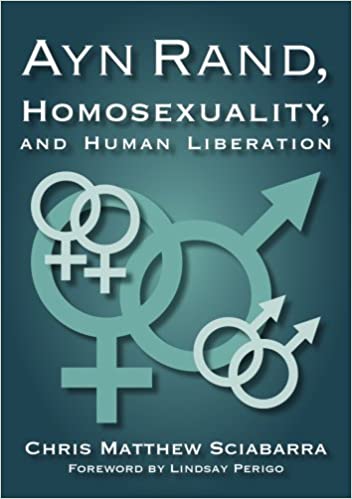Lindsay Perigo is a man on a mission. In his foreword to Chris Matthew Sciabarra’s Ayn Rand, Homosexuality, and Human Liberation, Perigo is determined to challenge Rand’s “outlandish view” of homosexuality, “in the very name of objectivism,” no less.
What was her view?
Rand, the Grand Dame of modern libertarianism, held that psychological immorality is at the root of homosexuality. She argued that homosexuality demonstrated “psychological flaws, corruptions, errors, or unfortunate premises.” While she declared that the government has no right to prohibit consenting sexual acts between adults, Rand made it clear that she found homosexuality personally repugnant.
Perigo has chosen the right man for the job. Sciabarra characteristically proves more than able. His book gets high marks from me. It is an elegantly written and riveting read. Sciabarra is eloquent in his description of the emotional damage suffered by gay objectivists as a result of the cruelty of their objectivist brothers and sisters. A chapter titled, “The Horror File,” is given over to personal accounts that document this unkindness.
Despite Sciabarra’s eloquence, I agree with Leonard Peikoff that “the subject is not part of the objectivist philosophy” (p. 10). Sciabarra admits as much, albeit in a different context (p. 14). Objectivism is a philosophy of individualism. Sexual orientation is a “nonessential” characteristic. “There’s no objectivist organization for straights or women or blacks, after all.”
In any event, great strides toward tolerance have been made by “post-Randian thinkers.” Barbara Branden, one of Rand’s first disciples, has noted the obvious: “The times they are a changing.” Many objectivists now concede that one is born to a sexual orientation, although the renowned psychologist and Rand disciple Nathaniel Branden (Barbara’s ex-husband) still treats homosexuals who want to become heterosexuals.
Such treatment might be futile, but Sciabarra goes even further in his condemnation. He considers it proof that “the heterosexual model of sexuality continues to inform the discussion.” Sciabarra also protests what he sees as an attempt by mainstream objectivists to “marginalize much of the incredible diversity in human sexuality.” I am afraid we are at odds here (and so, indubitably, would Rand be). Human sexuality isn’t that diverse, unless one considers a host of volitional behaviors about which a normative debate is perfectly proper. Yes, homosexuality is as innate as heterosexuality, but how one lives one’s sexuality is a legitimate object for ethical judgment.
Those who consider themselves heterosexual but have “just-for-fun homosexual contacts,” like Alberto (p.25), are more inclined to see sex as an expression of personal liberty and lifestyle than as an extension of a personal relationship. The attempt, moreover, to depict human sexuality as existing on a continuum and in a state of flux is as unsubstantiated as the inference that Rand herself might have been gay (Sciabarra dismisses this notion as having “zero credibility”; it is also utterly counterintuitive.)
Rand’s work has in the past been raped by assorted asexual, feminist interpretations, written mostly by the kind of women and men for whom, again, sex is a function of personal liberation (a tedious and leftist notion – Rand was neither). But no herstorical twists can change what a visceral – if intelligent – reading of Rand easily establishes. Sex to her was an elevated union between two outsized personalities, who are united in values and life force; a savage yet spiritual act of conquest. Sex to Rand had little to do with sexual expression and affirmation per se. Both are concepts that belong in the collectivist arena of gender and identity politics.
While Rand, a libertarian, would support the individual’s right to pursue happiness as he sees fit, I can’t see Kira Argounova of We the Living or Dagny Taggart of Atlas Shrugged acting out sexually as 23-year-old Alice does (p. 32). Alice describes herself as a feminist, an atheist, an objectivist and “queer” – open to bisexuality, bondage and domination, sadism and masochism, and multiple partners. Why is any objectivist obliged to consider Alice (very much the sexual antithesis of Rand) anything but a shock to the philosophical system that is objectivism?
The same can be said of the porn star who goes by the screen name Jon Galt. He (p. 3) might think his films – which include “Ride ’em Cowboy,” “At Large,” and “Finish Me Off” – embody Rand’s vision of man as heroic, “rational, passionate, creative, purposeful,” productive, and … private, but that doesn’t make it so. Are rational self-interest and personal happiness – all tenets of Rand’s philosophy – utterly relative concepts?
I might be mistaken, but I fear that what has emerged from Sciabarra’s many fascinating personal accounts is a liberal and permissive narrative about sexuality that serves to denude sex of its Randian majesty and meaning.
I prefer Sciabarra’s perceptive emphasis on the paramountcy of the “private” to ” Rand’s moral and cultural vision.” Rand, he notes, might have abhorred the “sexual imagery” that homosexuality conjures, but she “opposed any legal prohibition of sodomy, prostitution, or pornography,” because she rightly saw privacy as the hallmark of civilization. This value, however, needs to be applied beyond the legal realm. When Rand said that “the savage’s whole existence is public, ruled by the laws of his tribe,” it is impossible not to think of the rumbustious public project so many gays are dedicated to.
If “civilization is the progress toward a society of privacy,” in Rand’s magnificent words, then sexual exhibitionism – homosexual or heterosexual – is anathema. The heroic and creative inner struggle of an older generation of Gay Greats, exemplified by the late Nobel Prize-winning novelist Patrick White, was Randian at its best: silent and stoic, principled yet private. White was a hero in the Greek tradition.
©By ILANA MERCER
WorldNetDaily.com
July 9, 2004
CATEGORIES: Book Reviews, Feminism, Homosexuality, Objectivism, Sex & Sexuality

 print
print